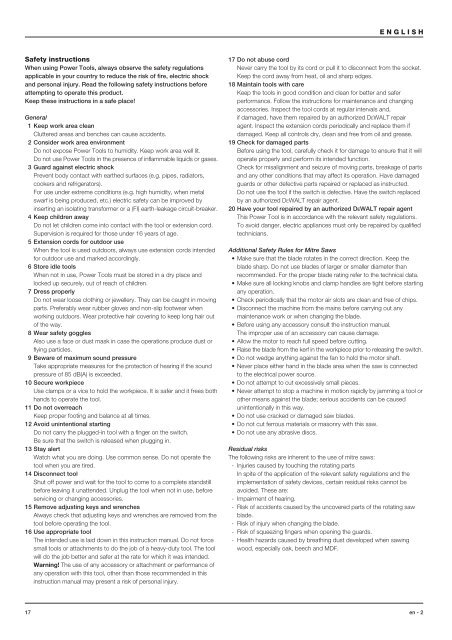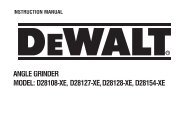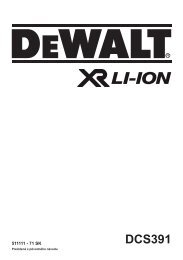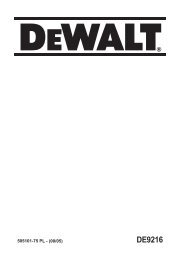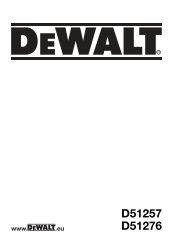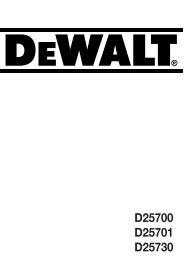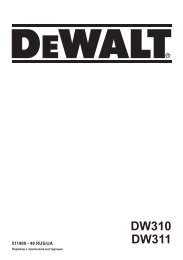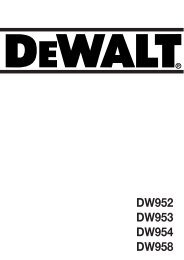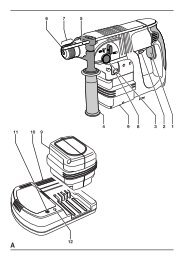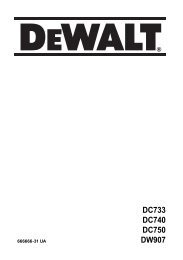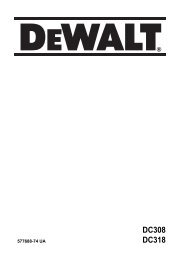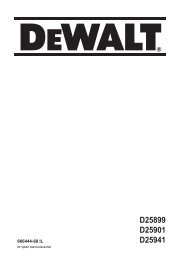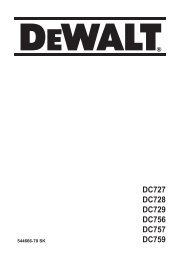DW701 DW707 - Service - DeWalt
DW701 DW707 - Service - DeWalt
DW701 DW707 - Service - DeWalt
Create successful ePaper yourself
Turn your PDF publications into a flip-book with our unique Google optimized e-Paper software.
Safety instructions<br />
When using Power Tools, always observe the safety regulations<br />
applicable in your country to reduce the risk of fire, electric shock<br />
and personal injury. Read the following safety instructions before<br />
attempting to operate this product.<br />
Keep these instructions in a safe place!<br />
General<br />
1 Keep work area clean<br />
Cluttered areas and benches can cause accidents.<br />
2 Consider work area environment<br />
Do not expose Power Tools to humidity. Keep work area well lit.<br />
Do not use Power Tools in the presence of inflammable liquids or gases.<br />
3 Guard against electric shock<br />
Prevent body contact with earthed surfaces (e.g. pipes, radiators,<br />
cookers and refrigerators).<br />
For use under extreme conditions (e.g. high humidity, when metal<br />
swarf is being produced, etc.) electric safety can be improved by<br />
inserting an isolating transformer or a (FI) earth-leakage circuit-breaker.<br />
4 Keep children away<br />
Do not let children come into contact with the tool or extension cord.<br />
Supervision is required for those under 16 years of age.<br />
5 Extension cords for outdoor use<br />
When the tool is used outdoors, always use extension cords intended<br />
for outdoor use and marked accordingly.<br />
6 Store idle tools<br />
When not in use, Power Tools must be stored in a dry place and<br />
locked up securely, out of reach of children.<br />
7 Dress properly<br />
Do not wear loose clothing or jewellery. They can be caught in moving<br />
parts. Preferably wear rubber gloves and non-slip footwear when<br />
working outdoors. Wear protective hair covering to keep long hair out<br />
of the way.<br />
8 Wear safety goggles<br />
Also use a face or dust mask in case the operations produce dust or<br />
flying particles.<br />
9 Beware of maximum sound pressure<br />
Take appropriate measures for the protection of hearing if the sound<br />
pressure of 85 dB(A) is exceeded.<br />
10 Secure workpiece<br />
Use clamps or a vice to hold the workpiece. It is safer and it frees both<br />
hands to operate the tool.<br />
11 Do not overreach<br />
Keep proper footing and balance at all times.<br />
12 Avoid unintentional starting<br />
Do not carry the plugged-in tool with a finger on the switch.<br />
Be sure that the switch is released when plugging in.<br />
13 Stay alert<br />
Watch what you are doing. Use common sense. Do not operate the<br />
tool when you are tired.<br />
14 Disconnect tool<br />
Shut off power and wait for the tool to come to a complete standstill<br />
before leaving it unattended. Unplug the tool when not in use, before<br />
servicing or changing accessories.<br />
15 Remove adjusting keys and wrenches<br />
Always check that adjusting keys and wrenches are removed from the<br />
tool before operating the tool.<br />
16 Use appropriate tool<br />
The intended use is laid down in this instruction manual. Do not force<br />
small tools or attachments to do the job of a heavy-duty tool. The tool<br />
will do the job better and safer at the rate for which it was intended.<br />
Warning! The use of any accessory or attachment or performance of<br />
any operation with this tool, other than those recommended in this<br />
instruction manual may present a risk of personal injury.<br />
ENGLISH<br />
17 Do not abuse cord<br />
Never carry the tool by its cord or pull it to disconnect from the socket.<br />
Keep the cord away from heat, oil and sharp edges.<br />
18 Maintain tools with care<br />
Keep the tools in good condition and clean for better and safer<br />
performance. Follow the instructions for maintenance and changing<br />
accessories. Inspect the tool cords at regular intervals and,<br />
if damaged, have them repaired by an authorized DEWALT repair<br />
agent. Inspect the extension cords periodically and replace them if<br />
damaged. Keep all controls dry, clean and free from oil and grease.<br />
19 Check for damaged parts<br />
Before using the tool, carefully check it for damage to ensure that it will<br />
operate properly and perform its intended function.<br />
Check for misalignment and seizure of moving parts, breakage of parts<br />
and any other conditions that may affect its operation. Have damaged<br />
guards or other defective parts repaired or replaced as instructed.<br />
Do not use the tool if the switch is defective. Have the switch replaced<br />
by an authorized DEWALT repair agent.<br />
20 Have your tool repaired by an authorized DEWALT repair agent<br />
This Power Tool is in accordance with the relevant safety regulations.<br />
To avoid danger, electric appliances must only be repaired by qualified<br />
technicians.<br />
Additional Safety Rules for Mitre Saws<br />
• Make sure that the blade rotates in the correct direction. Keep the<br />
blade sharp. Do not use blades of larger or smaller diameter than<br />
recommended. For the proper blade rating refer to the technical data.<br />
• Make sure all locking knobs and clamp handles are tight before starting<br />
any operation.<br />
• Check periodically that the motor air slots are clean and free of chips.<br />
• Disconnect the machine from the mains before carrying out any<br />
maintenance work or when changing the blade.<br />
• Before using any accessory consult the instruction manual.<br />
The improper use of an accessory can cause damage.<br />
• Allow the motor to reach full speed before cutting.<br />
• Raise the blade from the kerf in the workpiece prior to releasing the switch.<br />
• Do not wedge anything against the fan to hold the motor shaft.<br />
• Never place either hand in the blade area when the saw is connected<br />
to the electrical power source.<br />
• Do not attempt to cut excessively small pieces.<br />
• Never attempt to stop a machine in motion rapidly by jamming a tool or<br />
other means against the blade; serious accidents can be caused<br />
unintentionally in this way.<br />
• Do not use cracked or damaged saw blades.<br />
• Do not cut ferrous materials or masonry with this saw.<br />
• Do not use any abrasive discs.<br />
Residual risks<br />
The following risks are inherent to the use of mitre saws:<br />
- Injuries caused by touching the rotating parts<br />
In spite of the application of the relevant safety regulations and the<br />
implementation of safety devices, certain residual risks cannot be<br />
avoided. These are:<br />
- Impairment of hearing.<br />
- Risk of accidents caused by the uncovered parts of the rotating saw<br />
blade.<br />
- Risk of injury when changing the blade.<br />
- Risk of squeezing fingers when opening the guards.<br />
- Health hazards caused by breathing dust developed when sawing<br />
wood, especially oak, beech and MDF.<br />
17 en - 2


